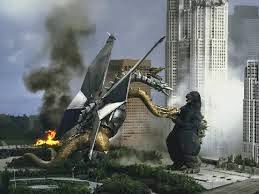Marking his 60th anniversary, Godzilla returns to the big screens — and American cinema! — in a feature film that doesn’t beg the question “Why?” but “What took you so long?” Seriously, the giant radioactive lizard has starred in nearly three dozen films: some good, some heinous, some best forgotten (such as Hollywood’s 1998 blunder).
Why do we love still Godzilla?
Is it the nostalgia — those wondrous weekend-long cable television marathons of cheesy miniature set-pieces being demolished by a man wearing a big rubber suit? Or perhaps there’s a deep, subconscious desire in which we can vicariously relish in Godzilla’s invulnerability and carefree ability to destroy and demolish without remorse or consequence. Seriously, I’d take a skyscraper over a stress-ball any day! (Theoretically…Also, this fictional building is empty…)
Or perhaps Godzilla’s longevity is connected to our natural curiosity to a world faltering into Armageddon. Even today, we conglomerate to the theater whenever there’s a film about the world on the brink of total annihilation. Whether TV’s “The Walking Dead”, movie comedies such as last year’s World’s End and This Is The End or even World War Z (a film that had everything against), audiences are devouring anything dealing with the apocalypse.
Godzilla was among the first films to highlight a foe seemingly unstoppable and capable of destroying the world. 1954’s original Godzilla was a Japanese product that used the big guy (I assume he’s a boy) as an allegory for the horrors of nuclear weaponry. Godzilla, being a creation of nuclear testing, surfaces above the Pacific Ocean and unleashes his wrath on all peoples without remorse or logic. It is a man in a suit, yes, but its melancholic, horrifying, and poignant. In a fitting bit of irony, Godzilla is vanquished by an even more terrible weapon.
Godzilla’s global popularity skyrocketed in the 1950s and 60, hearkening a new era of giant monsters from rival Japanese studios and other foreign film-makers. Godzilla’s celebrity was equalled only by King Kong, who was introduced a quarter-century earlier. But Kong was a different beast: he was an innocent victim of man’s greed. Godzilla, on the other hand, was a first-hand representative of mankind’s self-destruction. Inevitably, Toho Studios accrued the rights to Kong Kong and allowed him and Godzilla to duke it out in the 1962 film, which was the duo’s first fore in color film. Inevitably, to keep it mutual, the victor was ambiguous. (“We’ll call it a draw”).
I saw the original Godzilla long before I ever saw Kong. Although I regard the original Kong (1933) as the greatest monster movie ever created, I always placed myself in the Godzilla camp much like a teenaged girl would go with “Team Jacob”. The Godzilla movies soon transformed into mindless children entertainment. The plots were sparse, the human story was dull and always overcomplicated, but the creature effects were creative and dazzling. Each installment turned Godzilla against another creature. The latter films mutated into WWE free-for-alls where Godzilla formulated alliances and fought as the “babyface” for humanity. There’s even a moment when a victorious Godzilla shakes hands with his giant, humanoid partner.
Despite the quality corrosion, the films were always engaging — even when they became tongue-in-cheek fodder for “Mystery Science Theater”. The obvious man-in-a-rubber suit and miniature models created a aesthetic that was unique and magical. As the decades progressed, Toho Studios enhanced their special effects budget, but always maintained that Godzilla be given life by a man in a rubber suit and practical. Godzilla was put on hiatus twice and returned to Japanese cinemas in 1985 and 1999 respectively. The final Japanese wave came after the American version from 1998 failed to transform into a bone-fide franchise.
The newer versions attempted to remake many of Godzilla’s more famous installments, such as his bouts with the winged Mothra, the mechanized Mechagodzilla and his arch-nemesis, the three-headed, lightning-spouting, dragon-like King Ghidora.
I plan on seeing the newest Godzilla as soon as possible. Deep in the confines of my cynical, hardened adult exterior resides a little boy who likes seeing giant monsters break stuff. It’s what brought me to see Guillermo Del Toro’s Pacific Rim just one year ago. It’s what keeps me invested in a film saga that’s composed of nearly 30 feature films, two American remakes and a slew of cartoons and other pop-culture references that encompass Godzilla’s 60-year legacy.
Earlier, I posted my thoughts on the legacy of Freddy Krueger, who celebrated his 30th birthday this year. Godzilla is twice as old and has a legacy just as prominent to this day. Like Krueger, Godzilla remains iconic because of the numerous ways in which he was characterized. Although I appreciate Godzilla’s representation of our fears of nuclear fallout, I must confess that seeing Godzilla destroy giant robots, lizards, moths and skyscrapers alleviates my nerves almost as much as a Rum-and-Coke.
Despite the ripoffs, Godzilla remains one-of-a-kind and reigns supreme in our pop-culture. His very name preys on a multitude of fears, but also appeals to our imaginations. Whether its his trademark roar — which remains my favorite movie sound effects besides the light-saber buzz in Star Wars — his Stegosaurus spine and T-Rex biped stance, he’s recognizable even to those who’ve never watched a film. There’s a lot celebrate even if a new blockbuster wasn’t opening on this day. Somehow, he’s been able to stay relevant even as modern special effects and appetites have changed. Now, Godzilla has been re-imagined in America with glorified budget and modern effects. My review will be posted soon. But the big guy will stay ingrained in our conscience whether or not its a success. Even after 60 years, Godzilla still dominates the world.




